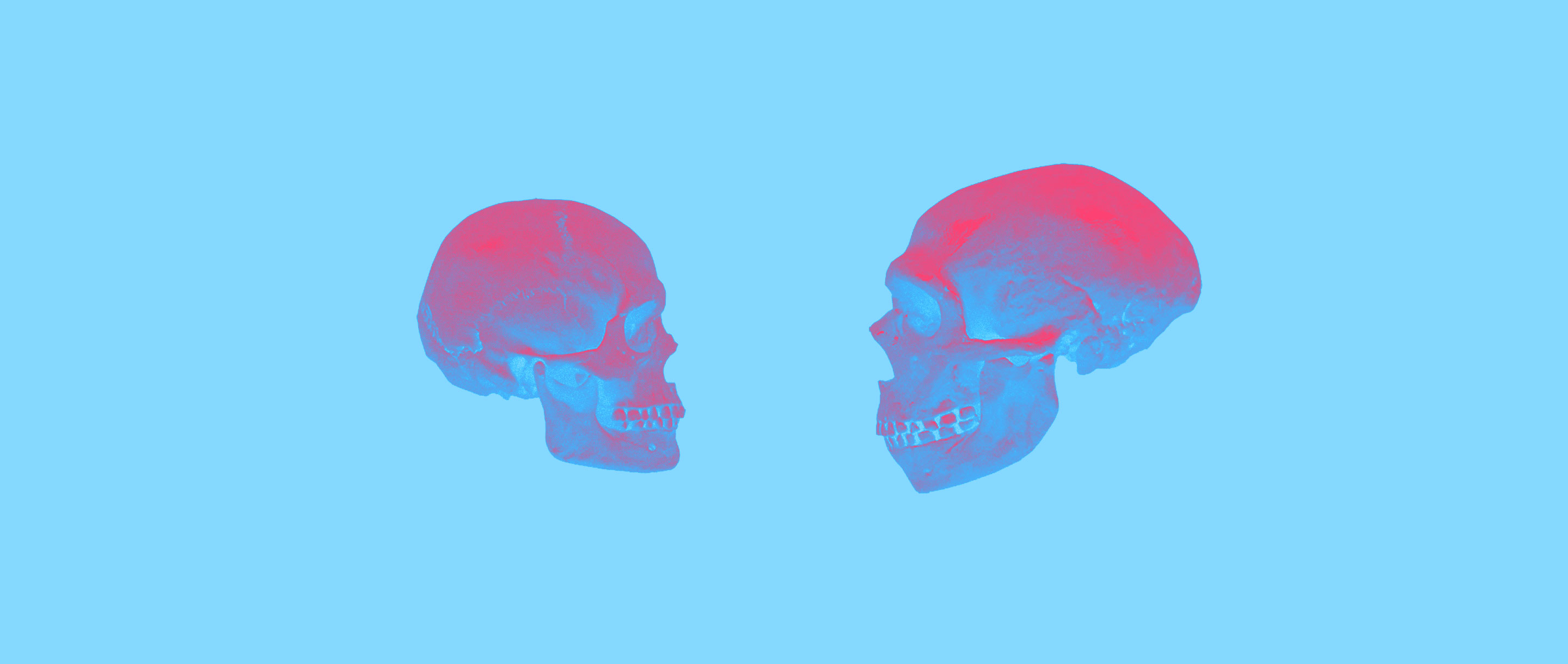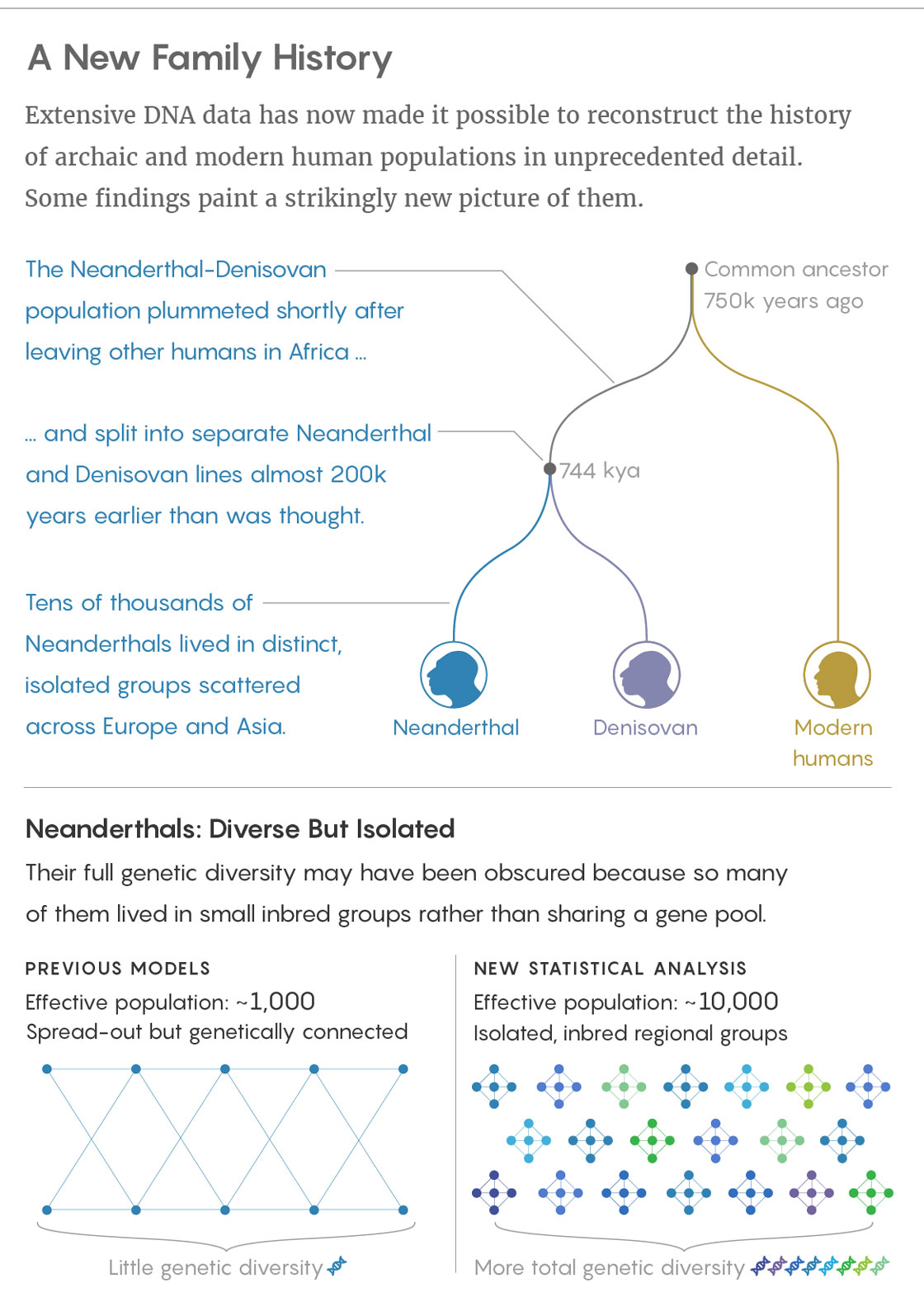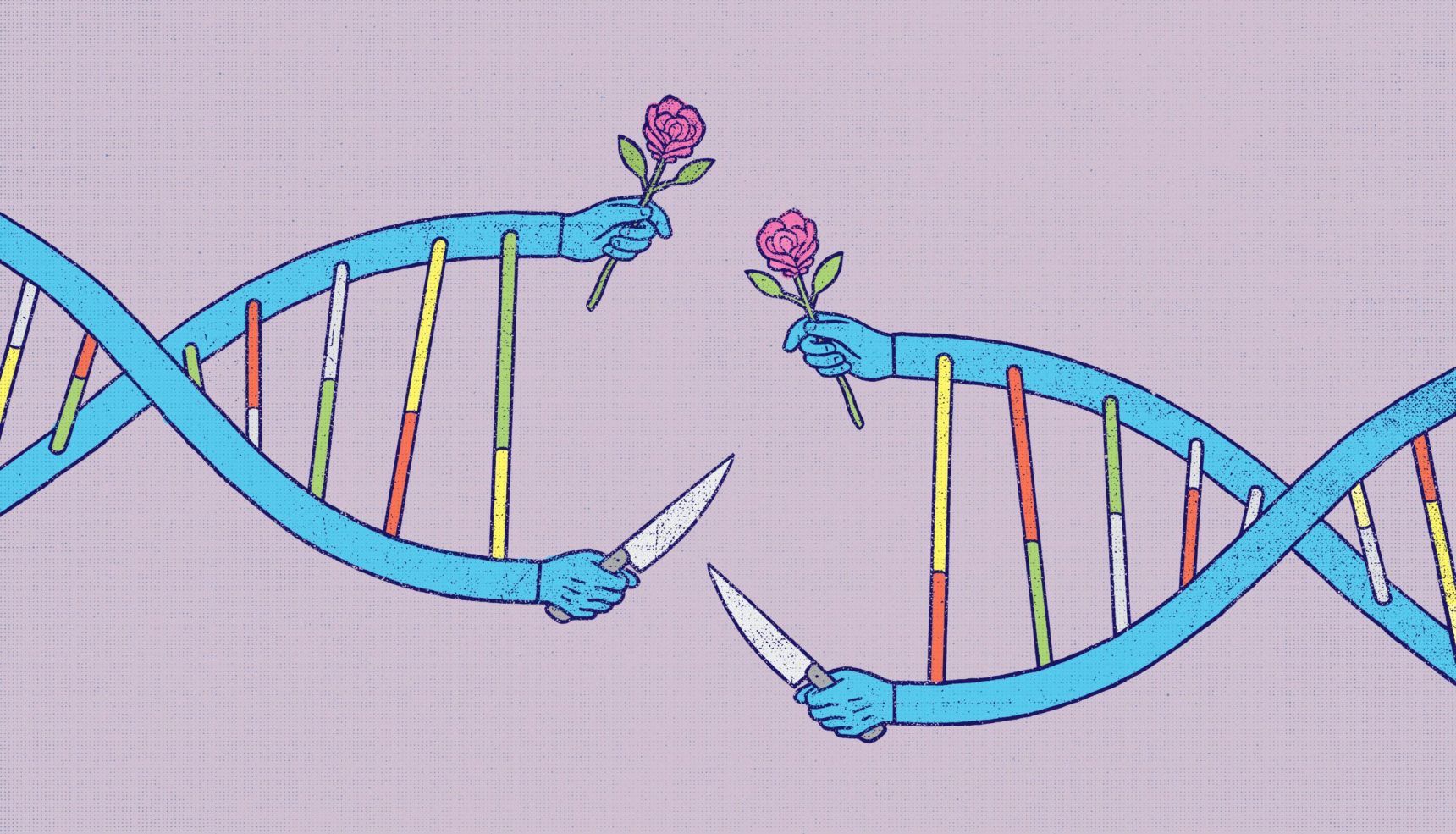Genetics Spills Secrets From Neanderthals’ Lost History

Modern humans (at left) and Neanderthals (right) were strikingly different in many respects. Yet a new genetic analysis suggests that Neanderthals may have had an out-of-Africa migratory experience not unlike our own.
Olena Shmahalo/Quanta Magazine; source: hairymuseummatt, DrMikeBaxter
Introduction
In 1856, three years before the publication of Charles Darwin’s On the Origin of Species, a group of miners uncovered human fossils in a limestone cave in the Neander Valley of northern Germany — what would later be named Neanderthal 1, the first specimen to be recognized as belonging to another, archaic species of human. We have been trying to understand as much as possible about our mysterious cousins ever since. To do so, experts have consulted two major lines of evidence: the hundreds of bones and stone tools found to date, scattered from Spain and England to the Altai Mountains, and, much more recently, genomic data and inferences drawn from statistical models.
But these approaches paint strikingly different pictures of what Neanderthal populations would have looked like. The archaeological record suggested that very roughly 150,000 individuals spanned Europe and Asia, living in small groups of 15 to 25 — and that their total numbers fluctuated greatly during the several climate cycles (which included harsh glacial periods) that occurred during the half a million years they inhabited Earth, before going extinct 40,000 years ago.
Genetic sequencing tells a different story. Some gene-based estimates put the Neanderthals’ effective population at a measly 1,000; others claim they hovered at a few thousand at most (one study, for example, calculated that there were effectively fewer than 3,500 females). Two hypotheses might account for these results: that the population was indeed that low, even at its peak, or that the population was perhaps larger but had been decreasing for a very long time. In either case, the Neanderthals were always on the decline; their extinction seemed to have been foretold from the beginning.
“The fact that these two kinds of estimates don’t match is an issue we have yet to work out,” said John Hawks, a paleoanthropologist at the University of Wisconsin-Madison.
Now, however, researchers led by Alan Rogers, an anthropologist and population geneticist at the University of Utah, have proposed a new genetic model that may reconcile those differences. It concludes that Neanderthals were more numerous than previous genetic studies often supposed, perhaps finally aligning genomic findings with the larger populations extrapolated from artifacts and fossils. It also fills in more of the Neanderthals’ evolutionary history between when they first separated from our ancestors in Africa and when they began to encounter modern humans again during the latter’s own diaspora. In many respects, Neanderthals may have been much more successful as a species — and more like us — than we have usually credited.
A Break With Convention
In population genetics, effective population size is not a direct measure of the total number of people that lived at a given time. It is rather a measure of genetic diversity. Experts trace an individual’s DNA back through history, looking for differences in the DNA sequences between the two copies of his or her genome. Essentially, they estimate how many generations of relatedness separate the maternal copy of a gene from the paternal copy. If a population is small, they can expect to reach the common ancestor relatively quickly; if it is larger, it takes longer. “It’s amazing that you can get this much information out of a single individual,” Rogers said.
Scientists’ longstanding impression has been that Neanderthals had low levels of genetic diversity. In African individuals today, approximately 11 of every 10,000 nucleotides are heterozygous, meaning they differ between two copies of a chromosome. In non-African individuals, only eight of every 10,000 sites are. That figure seemed to drop to a mere two of 10,000 for Neanderthals, as well as for their sister species, the Denisovans, which science only identified in the past decade. “Population genetics theory tells us that means a small population size” for those archaic humans, said Montgomery Slatkin, a biologist at the University of California, Berkeley, who was not convinced of Rogers’ results. That might mean 2,000 to 3,000 individuals — certainly not the far larger population inferred from the density of stone tools and fossils the Neanderthals left behind.
“If there were really only 1,000 Neanderthals in the whole world,” Rogers said, “it’s hard to believe there would be such a rich fossil record.”
But genetic evidence is exactly what Rogers and his colleagues have now cited to support their claim that the Neanderthals effectively numbered in the tens of thousands. They made their argument in a study published last month in the Proceedings of the National Academy of Sciences.
The key to this new result lies in the researchers’ assumption that Neanderthals had a much more diverse gene pool, but that it was divided into small, isolated, inbred groups of genetically similar individuals. This kind of fragmentation would have skewed the earlier genetic results: Estimates like that 2-in-10,000 number described the local populations and their regional histories but missed the big picture.
Rogers looked to make up for this shortcoming by adapting and extending a model of population mixing that other researchers had used. Instead of analyzing a single individual’s genome, he and his team compared genetic variants shared by modern Africans, modern Eurasians, Neanderthals and Denisovans. An earlier version of this model had been designed to estimate how much modern humans and Neanderthals interbred. Rogers’ main innovation was to add the Denisovans into the mix and significantly increase the number of ways different populations could combine and mingle. Doing so allowed him to ask questions that extended far beyond interbreeding to population size and other concerns.
The increase in genetic diversity that Rogers and his colleagues found corresponds to a roughly tenfold increase in effective population size. Although there is no way of knowing how many more Neanderthal individuals that number may represent, it could go a long way toward meeting the estimates from the fossil data.
“The study provides DNA evidence of what we were seeing in the archaeological record,” said Joshua Akey, an evolutionary biologist at Princeton University.
Out of Africa Twice
Working from the genetic sequences and their revised model, the researchers gleaned new insights into how Neanderthal, Denisovan and modern human populations grew, shrank, separated and periodically merged through prehistory. “We want to have a nice family tree, to be able to tell neat stories about how these groups were related,” said Steven Churchill, an anthropologist at Duke University. “But it’s clear these relationships are a lot more complicated.”

Lucy Reading-Ikkanda/Quanta Magazine
Approximately 750,000 years ago, according to Rogers, the forerunners of Neanderthals and Denisovans left the ancestors of modern humans behind in Africa to make their way across Eurasia’s expansive territory. Once on their own, something nearly wiped them out entirely; the genetic data shows the population passed through a severe bottleneck, never observed in previous studies. But whatever caused that brush with disaster, the archaic humans bounced back from it, and just a few thousand years later — by 744,000 years ago — they separated into two separate lineages, the Neanderthals and the Denisovans. The former then split further into the smaller regional groups that so fascinated Rogers.
The dating of that schism between the Neanderthals and the Denisovans is surprising because previous research had pegged it as much more recent: a 2016 study, for instance, set it at only 450,000 years ago. An earlier separation means we should expect to find many more fossils of both eventually. It also changes the interpretation of some fossils that have been found. Take the large-brained hominid bones belonging to a species called Homo heidelbergensis, which lived in Europe and Asia around 600,000 years ago. Paleoanthropologists have disagreed about how they relate to other human groups, some positing they were ancestors of both modern humans and Neanderthals, others that they were a nonancestral species replaced by the Neanderthals, who spread across Europe.
Rogers’ findings imply that the H. heidelbergensis had to have been an early Neanderthal. “The separation time we estimate is so early that a European hominid from 600,000 years ago pretty much has to be a Neanderthal,” he said, “at least genetically, even if they didn’t look entirely like Neanderthals yet.”
Coincidentally or otherwise, this new reconstruction of the Neanderthals’ complicated early history closely resembles what we learned about the populations of anatomically modern people who first spread into Europe and Asia. Nearly 50,000 years ago, Eurasians separated from Africans, experienced a bottleneck period during which their population was very low, and then splintered into regional populations throughout Eurasia — the so-called out-of-Africa theory of human migration. “It looks like the same thing happened 600,000 or 700,000 years ago” with the Neanderthals and Denisovans, Rogers said. “There was another out-of-Africa diaspora that no one had previously suspected.”
Not So Inferior After All
It’s no secret that the Neanderthals struggled: The glacial periods they endured and the fragmentation of their population left them unable to support robust social or technological growth. “But the one misconception people have is that we represent progress, that modern humans are the best and Neanderthals beneath us,” Hawks said. “When it comes to being hunters, being reliant on high-energy food resources in marginal environments, Neanderthals were the extreme.” He added, “They solved problems we don’t face today. How did they live at such low population densities for hundreds of thousands of years? That’s something we never managed.”
Before doing this research, Rogers thought that Neanderthals had been on the brink of extinction when modern humans entered their territories, that their populations were already dwindling and rife with genetic disease. “I no longer think that,” he said.
Understanding the true structure of the Neanderthal population may help scientists dig deeper and more productively into the dynamics of those ancient people and their interactions with us. For example, Akey said, one new question we might ask about interbreeding between modern humans and Neanderthals is whether there were any sexual biases in that gene flow. Did we incorporate equal amounts of maternal and paternal Neanderthal DNA, or was the scale tilted?
Rogers’ work and related research by other groups might be powerful for illuminating present-day genetics as well. Their analytical model can also be applied to dogs and horses — indeed, to any species that show structured breeding in their populations instead of random gene flow. The approach could also help elucidate the evolutionary history of some genetic diseases: Neanderthal genes have been linked to increased risks of depression, diabetes, heart disease and other disorders. Rogers’ findings could have implications for how different sets of these deleterious variants made their way into our genome. “If you want to study genetic history, you need to control for history,” Rogers said.
This article was reprinted on TheAtlantic.com.



